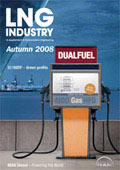Editorial comment
The global energy industry is undergoing a seismic shift. What we thought we knew for certain about oil and gas prices can no longer be relied upon.
Register for free »
Get started now for absolutely FREE, no credit card required.
The global energy industry is undergoing a seismic shift. What we thought we knew for certain about oil and gas prices can no longer be relied upon. High demand worldwide, but particularly in China and India, and a volatile market have seen oil prices approach US$ 150 per barrel of crude before dropping to a current US$ 125. Whilst just 12 months ago, oil prices even at this current level would have seemed untenable, today we just don’t know whether this will be the new norm or whether it is a temporary blip on the way to the US$ 250 per barrel of crude recently predicted by Gazprom. Of course, this is not an entirely objective assertion by the Russian state-owned oil and gas company, which is well placed to pro?t from a prolonged period of oil and gas prices at these elevated levels.
Many of the oil rich nations are not only enjoying substantially increased oil revenues but have become emboldened in their stance toward the major oil and gas companies. Reluctant to allow the likes of BP, Shell and ExxonMobil unfettered access to their hugely lucrative assets, they have increasingly been renegotiating existing contracts and where possible looking to develop their own reserves with the help of a growing army of highly experienced oilfield service companies.
For the major integrated oil and gas companies, faced with declining oil reserves and decreasing returns on investment, the LNG sector has become one of the last areas of real growth opportunity. LNG remains a costly and complex process and as such is well suited to the skills of the major oil and gas companies. Huge investment is required to link LNG production to its end user. However, as the recent ‘World LNG market report’, by Douglas Westwood observes, substantial investment has been earmarked and an anticipated US$ 106.8 billion will be spent in this sector between now and 2012.
The ability to harness stranded gas reserves in remote locations and transport them economically from one side of the earth to the other makes the LNG industry of vital strategic importance. A plethora of new terminal facilities in North America and western Europe demonstrate the acceptance of LNG as a key means of bolstering declining domestic gas reserves. However, it is Asia that will be the major focus for LNG development, attracting 43% of current investment according to the Douglas-Westwood report. This market with its rapidly increasing demand has been adversely affected by inconsistent and declining supply from traditional sources such as Indonesia. As LNG Industry correspondent, Ng Weng Hoong, reports in his article beginning on page 10, this has provided new opportunities for companies like BG, Total and Shell to extend their expertise from the purely technological and logistical challenges of oil and gas production to becoming specialist traders and suppliers. BG in particular has reported substantial growth in earnings in the first half of 2008 based on its ability to divert LNG cargoes to whatever market is prepared to pay the highest price. In 2008 this has meant shipping cargoes halfway around the world from Trinidad & Tobago to Japan and China instead of their intended US destination.
As the world economy starts to reassess a new era of oil and gas pricing, it is apparent that the LNG sector is rapidly becoming a vital element of the global energy supply chain. For major oil and gas companies, it is clear that the unique technological and entrepreneurial talents that they bring to the table are of considerable value to the LNG industry, which remains a fundamentally pioneering sector of the oil and gas industry and presents significant ongoing investment opportunities.


